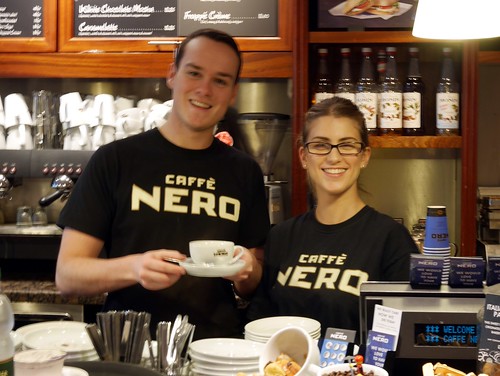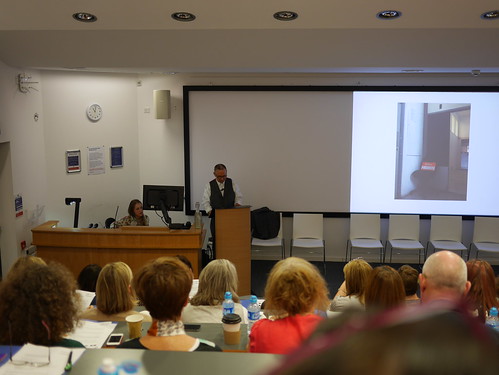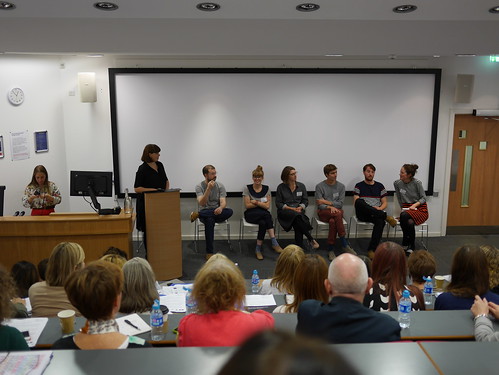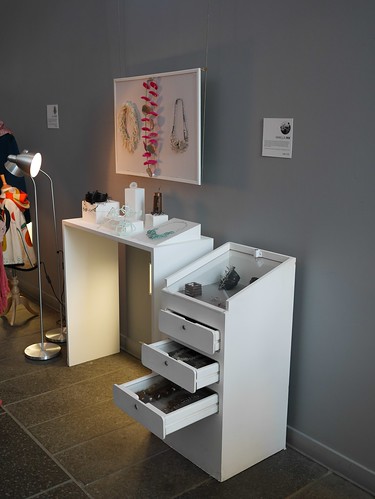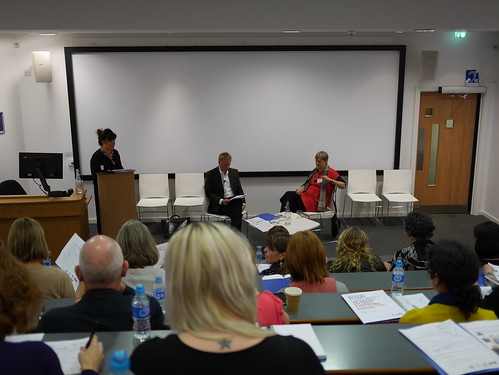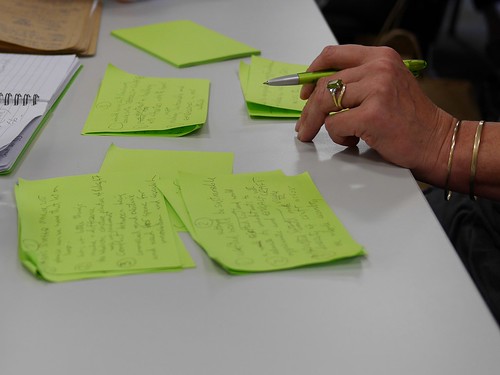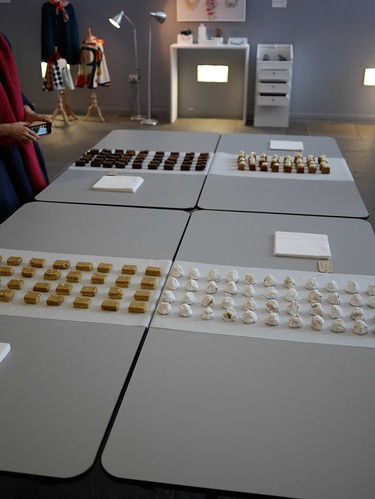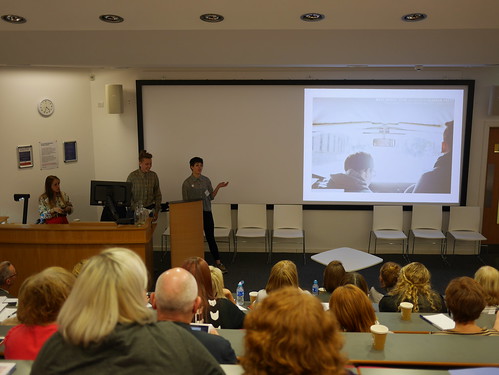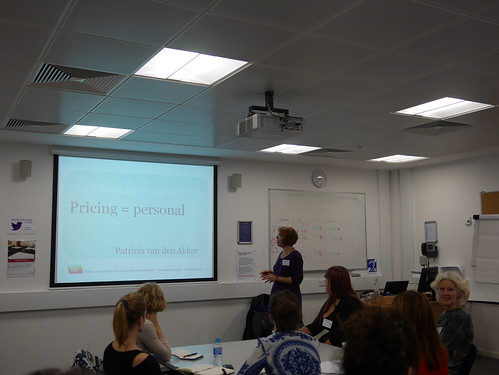Monday, October 07, 2013
Craft Scotland Conference
Posted by
Justified Sinner
I have just returned from Dundee where I attended the Craft Scotland conference for 2013. As I have blogged before, I have a lot of time for Craft Scotland. I don't think that there is another national organisation in the world which has quite the energy and enthusiasm for promoting the makers from the country it represents, yet it is a tiny organisation with a huge vision. The British Council, The Crafts Council and the others all do very well, but they seem in some ways a bit hide-bound and finally meeting with some of the positive, buzzing people behind Crafts Scotland was one of the real pleasures of the weekend.
I know that I keep banging on about how great Dundee and every visit to the place makes me wish more and more that I could live there. The day started well with the exceptionally cheerful - if somewhat mischievous - staff in Caffe Nero, where I went to use Wifi and have a coffee before things kicked off. They suggested that I might want to take "an action shot" of them doing their job and so I complied. Unfortunately, I was using my new camera and this blurred effort was all that came out but I promised them that I would put it on my blog, so here it is:
The conference kicked off with coffee and a general introduction. It was great to see Diane King again, whom I haven't seen for about 5 years, as well as Anne-Marie Shilito and also to be introduced to people whom I have never met or who have only associated with me by social media (social media featured a lot in the conference).
The event was opened by Janet Archer, head of Creative Scotland (some of you may recall me blogging about the problems that this hitherto shambolic organisation had encountered, culminating in the champagne-Cannes fiasco) and Janet has been brought to clean up their act. Creative Scotland oversees and funds Craft Scotland - and I can't help but feel that the names could have been better differentiated - but by some miracle, Craft Scotland seems to have managed to avoid the taint of the previous mismanagement of Creative Scotland. Janet Archer put several peoples' backs up - mine included - from the start of her presentation by suggesting that her background in "contemporary dance" allowed her to understand craft practices by using some vague and wispy dancing around with definitions. To her credit, even she seemed slightly uncomfortable with this idea and rapidly moved on to more believable points such as her determination to get Creative Scotland back on track - something which she does seem to have been achieving - and to continue to support Craft Scotland in what it is doing.
The keynote speaker for the event was the charismatic Professor Hans Stofer who spoke wittily and movingly about both his own practice and his beliefs about craft practice in general, beliefs which chimed in deeply with my own - there is always something very pleasing about having one's beliefs (prejudices?) backed up by someone whom one respects! He talked about the need for honesty, how "the need to make a mark is primal and absolute", about his love of outsider art, discussed "the joy of making" and mentioned how his role as a teacher could be described as being that of a "critical irritant". Well, I am sure some of my students would agree with that description of my own role.
The main thrust of his talk was about the role of the designer in wider society, about how it is no longer necessary - or even desirable - for art-school graduates to all become artists, about how makers and craftspeople, artists and designers all have a wider role in society as problem-solvers and "different thinkers". While he was optimistic and positive and utterly convincing and I couldn't help agreeing with my philosophic brain, my pragmatic was telling me "the cretinous Gove would never understand".
("The Cretinous Gove" sounds like a Lewis Carroll invention.)
Hans' speech did exactly what is expected of a keynote: it set the tone. At no point in the following two days did the mood of the conference dip from the optimistic high in which he set it and the organisers, Fiona Logue and Roanne Dods are to be commended on this inspired choice.
Hans Stofer was a hard act to follow and some people might have baulked at so doing, especially if they were young, recent graduates and being asked to talk about their deeply personal journeys towards balancing their creative and business practices, often admitting failures and mistakes with painful honesty.
From left to right in the above photograph, we have Alex Dobbie, Laura Spring, Catherine Aitken and David Murphy, and Tom and Anna Luntley.
Alex, a design engineer, talked about his collaborations with his brother who is a silversmith (you may recall that I was much taken with his work in the Glasgow School of Art degree show) and how they have worked together to solve problems allowing his brother to accept commissions which he might otherwise have had to reject. They are also collaborating on a range of jewellery for mass-production.
Laura was probably the most developed of the group of makers and had actually taken her work to full, commercial production and it was admirable the way in which she spoke so honestly and openly about her mistakes and the way she felt about aspects of her production, about the compromises she had to make to get things done and about rejecting offers which while lucrative, were not right for her business or creative practice.
Catherine and David talked about accepting a large commission for the Edinburgh Sculpture Workshops and how they then used the money and the space to create the furniture and fittings for that space. Interestingly, their idea is to use the equipment and expertise already within the workshops to create furniture within budget and which is exactly suitable for the space.
Probably one of the most talked-about presentations of the whole two days came from Tom and Anna of "Bakery 47". They are both fine artists and have turned to baking (the dread words "artisan" and "artisanal" featured!) to allow themselves to collaborate as a husband-and-wife team making bread and cakes whilst also making a living. From my own point of view, they are a delightful couple and their idea of making top-notch, fine-quality baked goods as a team is as good as any. Their "local" ethos is superb but their determination to do it ALL themselves is not sustainable and whilst many people were enchanted by their story - a superb story it is too, most marketable - there were one or two people who dissented enough to say "it is not sustainable" or "they are going to burn out". I wish them well and have even agreed to buy bread from them but I also think that their essential romanticism about "community" and the insular nature of their production is going to grind them down rapidly and I think that this is something which many small makers experience: their work is their life and they don't realise how much work they are doing until something gives. With Tom and Anna, they are very much community-based and it struck me and a few others that their business is perfect for converting into a community enterprise project, something which could then be rolled out into other communities, fitting in with not only their own ethos but with the general Zeitgeist.
Lunch!
Yes, all that was a morning's work.
During the lunch interval, we got a chance to meet and chat as well as look at Beth Lamont's thoughtfully-curated "We Dundee" craft show of makers from Dundee, including a stand of jewellery from Vanilla Ink (I blogged about them some time ago too!).
The afternoon was a bit of a curate's egg and started off with an unfocussed and vague conversation between Amanda Game - an experienced and talented curator with an impressive understanding of Scottish applied arts - and Philip Long, the director of the new V&A at Dundee.
Amanda's microphone only worked intermittently, which didn't help anything but at times they appeared to be talking at cross-purposes about different things and the whole event smacked of not having been properly discussed or planned beforehand. There were some interesting points made throughout the exchange but by the end there were more than a few people scratching their heads and I think there is an irony in that one of the isolated notes I made during the talk says "Precision of language"!
One of the useful things I got from the talk was of the idea that a "creative ecology" could be cultivated using "Technology, Talent and Tolerance".
This was a disappointing session as both Philip and Amanda are such luminaries that I had been hoping for something a bit more dynamic.
After this we all broke up into small groups to discuss the idea of a "Scottish Craft Renaissance", which was just what was needed after spending the morning and most of the afternoon in the lecture theatre and the debates were lively. One of the great advantages of this was that it introduced us all to people we hadn't met previously and allowed us to mix and find out a bit about each others' practices.
These sessions were the first place where I began to notice that there was an "elephant in the room", the elephant being the divisive and unpleasant one of "Independence" and the confusion between what I defined as "Craft Scotland" and "craft scottish". For me, any development of craft in Scotland has to be real and sustainable; it has to be about small makers and communities of makers and they have to be supportive of each other. What I am not talking about it a bunch of hobbyists selling at a loss or break-even at craft fairs or, worse, selling imported "made in China" tat which they have somehow wrangled a "Made in Scotland" or "Harris Tweed" label onto. A craft renaissance in Scotland has to be about micro-businesses and government, local, national or Salmond's Edinburgh-centric talking shop, MUST take on board the fact that there are loads of efficient, sustainable, ethical and ecological one- or two-person craft micro-businesses out there who do NOT want to grow (such as Natalie Fergie's hand-dyed wool). They do not need to grow and, indeed, growing could wreck their sustainability. Government agencies seem to see growth as the only measure of business success, completely neglecting that someone may live very sustainably on a smaller scale, providing a product or service to a community and in return keeping the economy of that local community ticking over.
Unfortunately, I spoke to many people who simply didn't get this idea. What was encouraging was that this was definitely in the sights of the business support people to whom I spoke - more on them later - but it seemed beyond the grasp of some of the more "hobbyist" people present and was even outright - and somewhat nastily - rejected by one person I spoke to who actually criticised my friend and colleague Angus Ross for employing people to help him make his furniture. (This person also said that they wouldn't support local craftspeople as they would rather buy from a multiple and spend the balance on "a nice dinner", openly laughed at me when I was pointing out the importance of makers supporting each other and then bleated complaints about IKEA's historic practice of ripping off independent desingers. An exception in the course of the conference, thankfully.)
The tension between "Craft Scotland" and the "Independence" debate was unfortunately not tackled. The one person from Craft Scotland with whom I attempted to discuss it quite understandably stuck to the line that "Craft Scotland" was not involved in politics and while I accept that she has to say this, it is essential that the issue is discussed in some way. At the moment, anything labelled "Scotland" or "Scottish" runs the risk of being associated with the pro-independence movement; there is a danger that Scottish Crafts - as practiced by any craft practitioner in Scotland, be they a Colombian-born Fair Isle knitter, me or a retired Berkshire-born teacher making ceramics in Fife - becomes associated with the nationalist agenda. As the vast majority of people in Scotland are anti-independence (67% at the last poll, myself included in that number), this could be detrimental to the craft renaissance.
I mentioned above that I had the idea that there was a difference between "Craft Scotland" and "craft scottish" and this is another of the issues about which I feel very strongly. I was horrified to discover - I think it was from Laura Spring, but I could be wrong - that a huge volume of Harris Tweed is bought up and shipped to China, where it is made into iPad covers, phone ocvers and the like. This then comes back to Scotland for "finishing" and has the Harris Tweed orb attached and a "Made In Scotland" label put on it. This is not only dishonest but is actually undermining craft practice and one of the roles that Craft Scotland should think about taking on is that of policing standards such as this. Is this a time for the creation of the crafts version of the British Kitemark? Perhaps a uniquely Scottish Craft Kitemark?
I realise that not everyone will agree with that. These are just my personal thoughts and I am sure that other participants took away other things.
Time to break for Cakes from Bakery 47!
The final session of the day was from Fi and Vana of the amazing project Makeworks:
Just to be clear, I will say from the outset that I do not think that Fi, Vana, their photographer Ross or their sponsors (Jerwood Trust and Creative Scotland) realise how important, how impressive or how useful this project is. Fi and Vana are funny and personable and while their presentation was dynamic and exciting, their project was more.
They set off in a VW Camper van and toured around Scotland for 90 days aiming to visit as many makers and suppliers as they could with a view to creating a directory of all the people in Scotland who could be drawn upon for craft practice: sandcasters, tanneries, jewellers, potters, stone-cutters, knife-makers, weavers, spinners... The only criteria for inclusion in the directory is that the organisation or person had to be prepared to work with anyone else. What this means is that they have created a directory of resources for craftspeople: should I, for example, require a piece of granite cut, I will be able to find out where to do that.
One of the advantages of living in a small country!
Day Two
Day two was all about small groups and presentations by a variety of speakers. I am delighted to say that I chose to go to the talk by the wonderful Patricia van den Akker of The Design Trust.
Patricia is a whirlwind of wit, imagination and energy and the first group I went to was her "Pricing Is Personal" seminar. I will confess to having an issue with pricing my work. I think that many small makers do. We get so close to what we are doing that we lose sight of the larger picture. Patricia spoke for almost two hours and not once did she touch on anything which wasn't relevant to the subject in hand. This talk was essential for any maker who feels that their pricing might not be appropriate for the value of their work and she addressed both psychological and economic issues which affect how we price things as well as giving guidance on how to change pricing practice and position your product within the market. When I have attended talks like this in the past, the speaker has often been from a business-school background and it is all about market anaylsis and margins or worse, there are graphs in the presentations. Patricia is a graphic design graduate and her mum ran a gift-shop in the Netherlands; she came to London and started work with New Designers, so her background is not business-school but craft and design, which is refreshing. She understands the issues. I was so completely taken with her presentation that I skipped out of my scheduled afternoon presentation by Maklab - I am already fairly clear about what they do: sorry, Richard! - and went to hers instead, where we learned about diversifying income streams which, again, sounds boring to anyone who is more at home in the studio but which I can assure you that it was useful and interesting and I am very glad that I decided to go to this event.
All makers will benefit from visiting The Design Trust website and Patricia's talk has fired me up to redevelop my website and to move to start selling work directly though the website
And that was the end. A quick vote of thanks from Fiona and Roanne and we all departed for our various modes of transport home. My own journey home by train was considerably lightened by meeting with Sally Johnston of "Starter for 6" an organisation developing business startups in the creative sectors. I cannot believe that we have never met before as it turned into one of those conversations where we knew all the same people, hung out in all the same places but had never actually even spotted each other!
A truly inspiring weekend.


